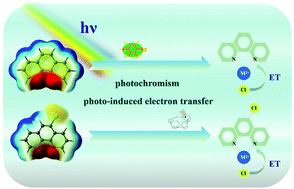Modulating the structure and photochromic performance of hybrid metal chlorides with nonphotochromic 1,10-phenanthroline and its derivative†
Abstract
Hybrid photochromic materias (HPMs), especially crystalline HPMs (CHPMs), have been widely investigated due to their feasibility in maintaining the advantages of each constituent and genearating captivating photomodulated functionality. Metal–organic complexes (MOCs), as promising candidates for fabricating CHPMs, have attracted the interest of researchers. The molecular predesign of ligands plays a crucial role in yielding MOC-based CHPMs with tunable photochromic functionality. Hitherto, a great majority of CHPMs are driven by photosensitive ligands. However, the complicated synthesis and high cost of photosensitive ligands obviously prevent the macro-synthesis and future application of these CHPMs. Thus, it is indispensable to explore novel branches of CHPMs. Herein, we report a series of photochromic solid materials bearing modulated photochromic properties by hybridizing metal chlorides with a nonphotosensitive coplanar dipyridine unit 1,10-phenanthroline (phen) and its derivative 5-chloro-1,10-phenanthroline (5-Cl-phen). The resulting hybrids, [ZnCl2(phen)] (1), [CdCl2(phen)] (2), [PbCl2(phen)] (3), [ZnCl(H2O)(5-Cl-phen)2]Cl·2H2O (4), [Cd2Cl4(5-Cl-phen)2] (5) and [Pb2Cl4(5-Cl-phen)2] (6), exhibit distinct structures from the isolated molecular complexes (1 and 4) to the hybrid chain (2, 3, 5 and 6) because of the distinct coordination mode of central metal ions and chloride ions. After photo-irradiation with a Xe-lamp, all complexes, as expected, exhibited apparent color change because of the photoinduced electron transfer (ET) between coordinated chloride ions (Cl−) as electron donors (EDs) and the coordinated coplanar phen and 5-Cl-phen species as electron acceptors (EAs). More importantly, the photochromic performance of the title complexes could be modulated by phen and 5-Cl-phen. This study provides a general and facile way for modulating the structure and photochromic performance of hybrid metal chlorides with phen or phen-based derivatives under the synergy of crystalline engineering strategy and ET mechanism.



 Please wait while we load your content...
Please wait while we load your content...